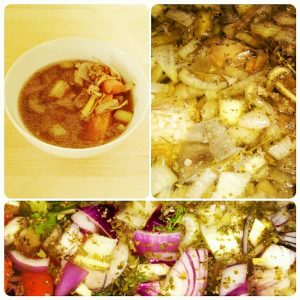So many cultures traditionally make a version of this mineral-rich goodness. It’s especially beneficial to your health at this time of year when the change of seasons is testing your resilience.
Health benefits of bone broth soup
:: inhibits infection
:: helps digestion
:: improves integrity of the gut lining
:: promotes healthy hair, skin and nails
:: reduces inflammation
:: ameliorates joint and bone health
:: strengthens and nourishes qi
Bone Broth Soup
Ingredients
- Bones from poultry, fish, shellfish, beef or lamb (make sure to know your source as lead and other heavy metals are stored in bones and you don’t want to be consuming that!)
- cook raw/cooked bones with or without meat
- use a whole carcass or just parts (feet, ribs, neck and knuckles)
- don’t forget shellfish shells, whole fish carcasses (with heads) or small dried shrimp
- in this particular batch, I also added organic, free-run eggshells as a natural source of glucosamine, chondroitin, etc.
- Water – start with cold water, enough just to cover the bones or 2 cups water per 1 lb bones
- Vinegar (unsulphured) – apple cider, red wine, rice or balsamic (the acid helps bones release minerals), a splash or 2 tbsp per 1quart water or per 2 lbs bones (lemon juice may be substituted)
- Vegetables – celery, carrots, onions, garlic and parsley are most traditionally used but any will do – if added towards the end of cooking, mineral content will be higher. For this particular batch, I used celery, carrots, onions, garlic, fresh thyme, peppercorns, cloves, sea salt, and bay leaves.
Directions
Combine bones, water and vinegar in a pot, let stand 30 minutes to 1 hour. Bring to a boil, remove any scum that has risen to the top, reduce heat and simmer (6-48 hours for chicken, 12-72 hours for beef). To reduce cooking time, you may smash or cut bones in to small pieces first. If desired, add vegetables in the last ½ hour of cooking (or at any point as convenience dictates). Strain through a colander or sieve, lined with cheesecloth for a clearer broth. Discard the bones. If uncooked meat was used to start with, reserve the meat for soup or salads.
